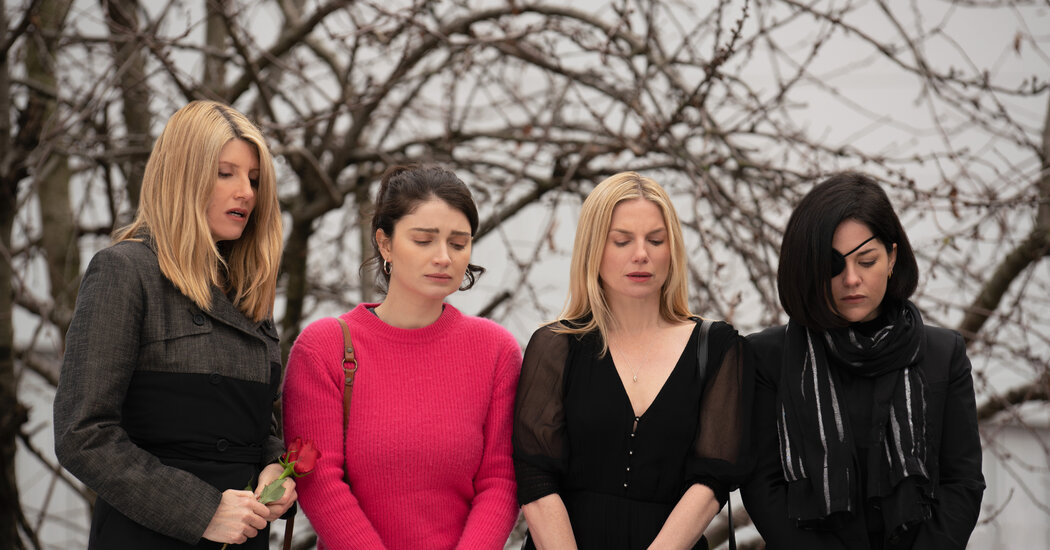‘Bad Sisters’ Review: The Family That Kills Together (Maybe)

A despicable male is found dead, and the prime suspects are a group of women who wanted to protect one of their number from his constant oppression. The killer or killers are eventually revealed; a lot of driving is done up and down a picturesque coastline. It’s the “Big Little Lies” scenario, but “Bad Sisters,” premiering Friday on Apple TV+, adds something new and refreshing to the formula: a sense of humor.
The Irish writer and performer Sharon Horgan, who created “Bad Sisters” with Dave Finkel and Brett Baer, has been behind some of the most caustically funny shows on British television this century, like “Pulling” (raucous female friendship) and “Catastrophe” (the chaos of marriage). Earlier this year, she branched out, recasting “The Shining” as a family sitcom in “Shining Vale” on Starz.
“Shining Vale” and “Bad Sisters” don’t send up the horror and avenging-women-thriller genres; they employ humor, strategically and affectionately, to give the genres new life. The 10 hourlong episodes of “Bad Sisters” (based on a Belgian series, “Clan”) tell a serious story about the damage that ripples outward from one angry and devious man, but Horgan and her collaborators use the structures of comedy to maintain energy and keep up our interest, and they mostly avoid the tendencies toward moralism and melodrama that this sort of narrative often lapses into.
The villain of “Bad Sisters” is John Paul Williams (Claes Bang), who works in the finance department of a Dublin architecture firm. We first see him in his coffin at his wake, which is where we’re introduced to the five sisters of the title: Grace, his long-suffering wife (Anne-Marie Duff), and his in-laws Eva (Horgan), Ursula (Eva Birthistle), Bibi (Sarah Greene) and Becka (Eve Hewson).
The circumstances of John Paul’s death are kept from us until late in the series, but we know that it has been ruled an accident because Tom (Brian Gleeson) and Matt (Daryl McCormack), a pair of slightly feckless half brothers who own a small and failing insurance agency, have set out to prove otherwise. If they can show that it was murder, they won’t have to pay off on the life-insurance policy that Grace holds.
Their stumbling but bullheaded progress — they’re like low-rent cousins of Edward G. Robinson in “Double Indemnity” — is one of the show’s clever comic storytelling devices. The investigation they carry out is remarkably effective, largely because no one gives much thought to talking with them, and the audience is always a step or two ahead in putting together the facts they’re uncovering.
Tom and Matt unwittingly guide us through the larger story, in which continual flashbacks illustrate John Paul’s awfulness and the increasingly dire steps the sisters take in response. Each sister proves to have her own reason to want him dead, which complicates the narrative and fills out the 10 episodes. The most baroque of these subplots involves the loss of one of Bibi’s eyes, which requires Greene to wear a pirate-like eye patch that’s a neat visual joke in its own right.
The trickiness and delayed revelations mean that “Bad Sisters” is a forest of spoilers, about which it can perhaps safely be said that the sisters-in-law find themselves willing to contemplate murder and that John Paul proves, through a series of misadventures that are grisly in nature and slapstick in form, to be comically indestructible, right up until he isn’t.
Beyond the smart construction and tart dialogue, especially in the episodes (four of 10) written or co-written by Horgan, “Bad Sisters” succeeds because the five lead actresses convince us that they’re a family unit, sometimes for worse but mostly for better. The characters are types — strong and overprotective Eva, angry Bibi, flighty but sensible Becka — but the performers make them distinctive and make us feel their fierce devotion to one another.
Particularly good is Duff in the difficult, thankless role of Grace, who sticks with John Paul despite being gaslighted, debased and controlled; it would be easy to write her off and disengage from the show, but Duff keeps us with her, showing the layers of insecurity, fear and honest devotion that make sense of the character.
The real key to the show, though, is the performance by Bang, who pulls off an even more impressive feat with John Paul, expertly portraying his ghastliness while also rendering him as absolutely human and never for a moment descending into caricature. John Paul’s sociopathy is, with a few exceptions, a matter of conversational malevolence and tactical maneuvering rather than physical violence, and Bang executes his attacks with the self-satisfied joy of a childish virtuoso; instead of playing up monstrousness or soullessness, he puts a twinkle in John Paul’s eye and a hint of uncertainty beneath his bravado, and you can’t take your own eyes off him.
